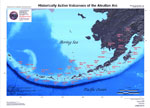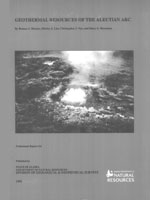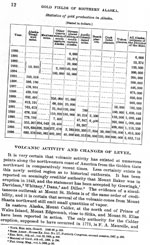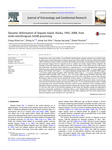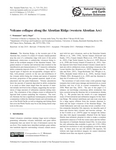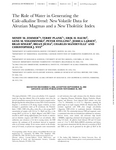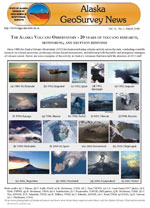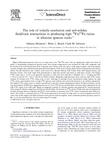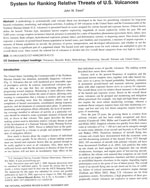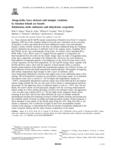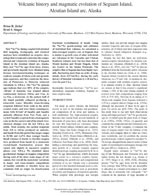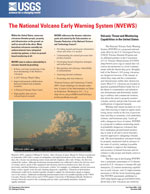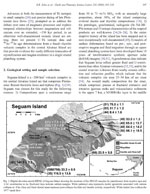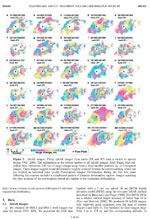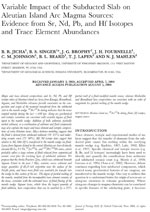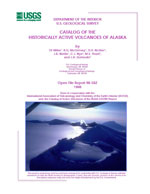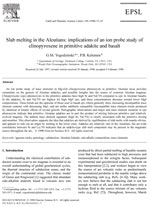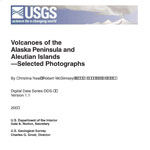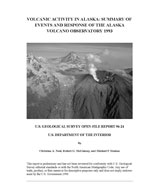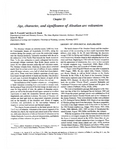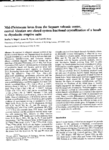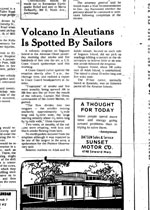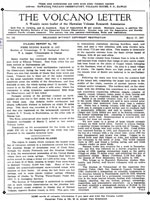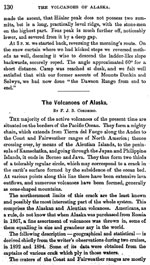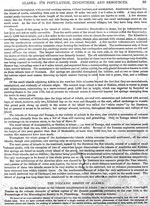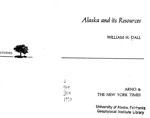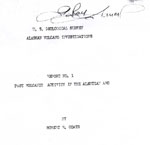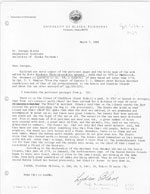References
Wang, J., 2024, Deformation mapping and modeling of the Aleutian volcanoes with InSAR and numerical models: University Park, Tex., Southern Methodist University, Ph.D. dissertation, 143 p.
Cameron, C.E., Bull, K.F., and Macpherson, A.E., 2023, Recently active volcanoes of Alaska: Alaska Division of Geological & Geophysical Surveys Miscellaneous Publication 133 v. 6, 2 sheets. https://doi.org/10.14509/31086.
Wang, J., Lu, Z., Bekaert, D., Marshak, C., Govorcin, M., Sangha, S., Kennedy, J., and Gregg, P., 2023, Along-arc volcanism in the western and central Aleutian from 2015 to 2021 revealed by cloud-based InSAR processing: Geophysical Research Letters v. 50, no. 23, e2023GL106323. https://doi.org/10.1029/2023GL106323
Alaska Volcano Observatory, National Oceanic and Atmospheric Administration, National Weather Service, Federal Aviation Administration, Department of Defense, United States Coast Guard, Division of Homeland Security and Emergency Management, Alaska Department of Environmental Conservation, and Alaska Department of Health and Social Services (participating agencies), 2022, Alaska interagency operating plan for volcanic ash episodes, 85 p.
Cameron, C.E., Crass, S.W., and AVO Staff, eds, 2022, Geologic database of information on volcanoes in Alaska (GeoDIVA): Alaska Division of Geologic and Geophysical Surveys Digital Data Series 20, https://doi.org/10.14509/geodiva, https://doi.org/10.14509/30901.
Reath, K., Pritchard, M.E., Roman, D.C., Lopez, T., Carn, S., Fischer, T.P., Lu, Z., Poland, M.P., Vaughan, R.G., Wessels, R., Wike, L.L., and Tran, H.K., 2021, Quantifying eruptive and background seismicity, deformation, degassing, and thermal emissions at volcanoes in the United States during 1978-2020: Journal of Geophysical Research: Solid Earth, v. 126, e2021JB021684, doi: 10.1029/2021JB021684.
Cameron, C.E., Schaefer, J.R., and Ekberg, P.G., 2020, Historically active volcanoes of Alaska: Alaska Division of Geological & Geophysical Surveys Miscellaneous Publication 133 v. 4, 2 sheets. Http://doi.org/10.14509/30426
Lerner, A.H., O'Hara, D., Karlstrom, L., Ebmeier, S.K., Anderson, K.R., and Hurwitz, S., 2020, The prevalence and significance of offset magma reservoirs at arc volcanoes: Geophysical Research Letters, v. 47, doi:10.1029/2020GL087856.
Lerner, A.H., 2020, The depths and locations of magma reservoirs and their consequences for the behavior of sulfur and volcanic degassing: University of Oregon Ph.D. thesis, 378 p. Available at https://search.proquest.com/openview/cec1ff16af338dce2495b5a1a491aa88/1?pq-origsite=gscholar&cbl=44156.
Rasmussen, D.J., Plank, T.A., Wallace, P.J., Newcombe, M.E., and Lowenstern, J.B., 2020, Vapor-bubble growth in olivine-hosted melt inclusions: American Mineralogist, v. 105, no. 12, p. 1898-1919, https://doi.org/10.2138/am-2020-7377.
Mulliken, K.M., 2018, The Alaska Volcano Observatory: 30 years of protecting Alaskans from the effects of volcanic activity (1988-2018): Alaska Division of Geological & Geophysical Surveys Information Circular 67, 2 p. http://doi.org/10.14509/30032
Ewert, J.W., Diefenbach, A.K., and Ramsey, D.W., 2018, 2018 update to the U.S. Geological Survey national volcanic threat assessment: U.S. Geological Survey Scientific Investigations Report 2018-5140, 40 p., https://pubs.usgs.gov/sir/2018/5140/sir20185140.pdf.
Cameron, C.E., Schaefer, J.R., and Mulliken, K.M., 2018, Historically active volcanoes of Alaska: Alaska Division of Geological & Geophysical Surveys Miscellaneous Publication 133 v. 3, 2 sheets. Http://doi.org/10.14509/30142
Jicha, B.R., and Kay, S.M., 2018, Quantifying arc migration and the role of forearc subduction erosion in the central Aleutians: Journal of Volcanology and Geothermal Research, v, 360, p. 84-99, doi: http://dx.doi.org/10.1016/j.jvolgeores.2018.06.016.
Cameron, C.E., and Schaefer, J.R., 2016, Historically active volcanoes of Alaska: Alaska Division of Geological & Geophysical Surveys Miscellaneous Publication 133 v. 2, 1 sheet, scale 1:3,000,000. http://doi.org/10.14509/20181
Lloyd, A.S., Ferriss, E., Ruprecht, P., Hauri, E.H., Jicha, B.R., and Plank, T., 2016, An assessment of clinopyroxene as a recorder of magmatic water and magma ascent rate: Journal of Petrology, v. 57, n. 10, p. 1865-1886.
Cameron, C.E., and Snedigar, S.F., 2016, Alaska Volcano Observatory image database: Alaska Division of Geological & Geophysical Surveys Digital Data Series 13, https://www.avo.alaska.edu/images/. https://doi.org/10.14509/29689.
Schaefer, J.R., Cameron, C.E., and Nye, C.J., 2014, Historically active volcanoes of Alaska: Alaska Division of Geological & Geophysical Surveys Miscellaneous Publication 133 v. 1.2, 1 sheet, scale 1:3,000,000.
This publication has been superseded. Newest version available at http://www.dggs.alaska.gov/pubs/id/20181 .
Lu, Zhong, and Dzurisin, Daniel, 2014, InSAR imaging of Aleutian volcanoes: Chichester, UK, Springer-Praxis, 390 p.
Lee, Chang-Wook, Lu, Zhong, Won, Joong-Sun, Jung, Hyung-Sun, and Dzurisin, Daniel, 2013, Dynamic deformation of Seguam Island, Alaska, 1992-2008, from multi-interferogram InSAR processing: Journal of Volcanology and Geothermal Research, v. 260, p. 43-51, doi:10.1016/j.jvolgeores.2013.05.009
Montanaro, C., and Beget, J., 2011, Volcano collapse along the Aleutian Ridge (western Aleutian Arc): Natural Hazards and Earth System Sciences, v. 11, n. 3., p. 715-730, available online at http://www.nat-hazards-earth-syst-sci.net/11/715/2011/nhess-11-715-2011.pdf .
Yogodzinski, G.M., Vervoort, J.D., Brown, S.T., and Gerseny, M., 2010. Subduction controls of Hf and Nd isotopes in lavas of the Aleutian island arc: Earth and Planetary Science Letters, v. 300, p. 226-238, doi: 10.1016/j.epsl.2010.09.035 .
Zimmer, M.M., Plank, Terry, Hauri, E.H., Yogodzinski, G.M., Stelling, Peter, Larsen, Jessica, Singer, Brad, Jicha, Brian, Mandeville, Charles, and Nye, C.J., 2010, The role of water in generating the calc-alkaline trend: new volatile data for Aleutian magmas and a new tholeiitic index: Journal of Petrology, v. 5, n. 12, p. 2411, 2444, doi:10.1093/petrology/egq062 .
Waythomas, C.F., Watts, Philip, Shi, Fengyan, and Kirby, J.T., 2009, Pacific Basin tsunami hazards associated with mass flows in the Aleutian arc of Alaska: Quaternary Science Reviews, v. 28, p. 1006-1019, doi:10.1016/j.quascirev.2009.02.019 .
Snedigar, S.F., and Cameron, C.C., 2009, Historically active volcanoes of Alaska reference deck: Alaska Division of Geological & Geophysical Surveys Information Circular 59, 52 p, available to order from http://www.dggs.dnr.state.ak.us/pubs/pubs?reqtype=citation&ID=20401 .
Diefenbach, A.K., Guffanti, Marianne, and Ewert, J.W., 2009, Chronology and references of volcanic eruptions and selected unrest in the United States, 1980-2008: U.S. Geological Survey Open-File Report 2009-1118, 85 p., available at http://pubs.usgs.gov/of/2009/1118/ .
Mastin, L.G., Guffanti, Marianne, Ewert, J.E., and Spiegel, Jessica, 2009, Preliminary spreadsheet of eruption source parameters for volcanoes of the world: U.S. Geological Survey Open-File Report 2009-1133, v. 1.2, 25 p., available at http://pubs.usgs.gov/of/2009/1133/ .
Zimmer M. M., 2009, Water in Aleutian Magmas: its origins in the subduction zone and its effects on magma evolution: Boston University Ph.D. dissertation, 356 p.
Hard Copy held by AVO at FBKS - CEC shelf
Schaefer, J.R., and Nye, Chris, 2008, The Alaska Volcano Observatory - 20 years of volcano research, monitoring, and eruption response: Alaska Division of Geological & Geophysical Surveys, Alaska GeoSurvey News, NL 2008-001, v. 11, n. 1, p. 1-9, available at http://wwwdggs.dnr.state.ak.us/pubs/pubs?reqtype=citation&ID=16061 .
University of Alaska Fairbanks Geophysical Institute, 2008, 20th anniversary of the Alaska Volcano Observatory: University of Alaska Geophysical Institute pamphlet, 2 p.
Heimann, Adriana, Beard, B.L., and Johnson, C.M., 2008, The role of volatile exsolution and sub-solidus fluid/rock interactions in producing high 56Fe/54Fe ratios in siliceous igneous rocks: Geochimica et Cosmochimica Acta, v. 72, n. 17, p. 4379-4396, doi: 10.1016/j.gca.2008.06.009 .
Lu, Zhong, 2007, InSAR imaging of volcanic deformation over cloud-prone areas - Aleutian Islands: Photogrammetric Engineering and Remote Sensing, v. 73, n. 3, p. 245-257.
Ewert, John, 2007, System for ranking relative threats of U.S. volcanoes: Natural Hazards Review, v. 8, n. 4, p. 112-124.
Singer, B.S., Jicha, B.R., Leeman, W.P., Rogers, N.W., Thirlwall, M.F., Ryan, Jeff, and Nicolaysen, K.E., 2007, Along-strike trace element and isotopic variation in Aleutian Island arc basalt: subduction melts sediments and dehydrates serpentine: Journal of Geophysical Research, v. 112, n. B6, 26 p., doi: 10.1029/2006JB004897 .
Jicha, B.R., and Singer, B.S., 2006, Volcanic history and magmatic evolution of Seguam Island, Aleutian island arc, Alaska: Geological Society of America Bulletin, v. 118, n. 7-8, p. 805-822.
Dixon, J.P., Stihler, S.D., Power, J.A., Tytgat, Guy, Estes, Steve, and McNutt, S.R., 2006, Catalog of earthquake hypocenters at Alaskan volcanoes: January 1 through December 31, 2005: U.S. Geological Survey Open-File Report 2006-1264, 78 p., available at http://pubs.usgs.gov/of/2006/1264/ .
Ewert, John, Guffanti, Marianne, Cervelli, Peter, and Quick, James, 2006, The National Volcano Early Warning System (NVEWS): U.S. Geological Survey Fact Sheet FS 2006-3142, 2 p., available at http://pubs.usgs.gov/fs/2006/3142 .
Jicha, B.R., 2006, Geochronic and isotopic constraints on the magmatic evolution of Pleistocene-Recent Aleutian and Andean volcanic complexes: University of Wisconsin Madison Ph.D. dissertation, 195 p.
Ewert, J.W., Guffanti, Marianne, and Murray, T.L., 2005, An assessment of volcanic threat and monitoring capabilities in the United States: framework for a National Volcano Early Warning System NVEWS: U.S. Geological Survey Open-File Report 2005-1164, 62 p.
Jicha, B.R., Singer, B.S., Beard, B.L., Johnson, C.M., 2005, Contrasting timescales of crystallization and magma storage beneath the Aleutian Island arc: Earth and Planetary Science Letters, v. 236, p. 195-210.
Lu, Z., Wicks, C., Dzurisin, D., and Power, J., 2005, InSAR studies of Alaska volcanoes: Korean Journal of Remote Sensing v. 21, no. 1, pg. 59-72. https://doi.org/10.7780/kjrs.2005.21.1.59
Masterlark, Tim, and Lu, Zhong, 2004, Transient volcano deformation sources imaged with interferometric synthetic aperture radar: application to Seguam Island, Alaska: Journal of Geophysical Research, v. 109, n. 1, p. 1-16.
Price, E.J., 2004, Dynamic deformation of Seguam Island, Aleutian Islands, Alaska, 1993-2000: implications for magmatic and hydrothermal processes: Journal of Geophysical Research, v. 109, n. 4, 15 p.
Jicha, B.R., Singer, B.S., Brophy, J.G., Fournelle, J.H., Johnson, C.M., Beard, B.L., Lapen, T.J., and Mahlen, N.J., 2004, Variable impact of the subducted slab on Aleutian island arc magma sources; evidence from Sr, Nd, Pb, and Hf isotopes and trace element abundances: Journal of Petrology, v. 45, n. 9, p. 1845-1875.
Siebert, L., and Simkin, T., 2002-, Volcanoes of the world: an illustrated catalog of Holocene volcanoes and their eruptions: Smithsonian Institution, Global Volcanism Program Digital Information Series GVP-3, http://volcano.si.edu/search_volcano.cfm, unpaged internet resource.
Cameron, C. E., Triplehorn, J. H., and Robar, C. L., 2003, Bibliography of information on Alaska volcanoes: Alaska Division of Geological & Geophysical Surveys Miscellaneous Publication MP 131, 1 CD-ROM.
Hard Copy held by AVO at FBKS - CEC file cabinet
Lu, Zhong, Wicks, C. J., Dzurisin, Daniel, Power, John, Thatcher, Wayne, and Masterlark, Tim, 2003, Interferometric synthetic aperture radar studies of Alaska volcanoes: Earth Observation Magazine, v. 12, n. 3, p. 8-10.
Kelemen, P.B., Yogodzinski, G.M., and Scholl, D.M., 2003, Along-strike variation in the Aleutian Island Arc: Genesis of high Mg# andesite and implications for continental crust, in Eiler, J., ed., Inside the Subduction Factory: AGU Monograph 138, p. 223-276.
Jicha, B. R., 2002, Variable impact of the subducted slab on Aleutian Island arc magma sources; evidence from Sr, Nd, Pb, and Hf isotopes and trace element abundances: University of Wisconsin Madison unpublished M.S. thesis, 85 p.
Schaefer, Janet, and Nye, C. J., 2002, Historically active volcanoes of the Aleutian Arc: Alaska Division of Geological & Geophysical Surveys Miscellaneous Publication MP 0123, unpaged, 1 sheet, scale 1:3,000,000. Superceded by Miscellaneous Publication 133: http://www.dggs.dnr.state.ak.us/pubs/pubs?reqtype=citation&ID=20181
Wallace, K. L., McGimsey, R. G., and Miller, T. P., 2000, Historically active volcanoes in Alaska, a quick reference: U.S. Geological Survey Fact Sheet FS 0118-00, 2 p.
Hard Copy held by AVO at FBKS - CEC file cabinet
Sigurdsson, Haraldur, (ed.), 2000, Encyclopedia of volcanoes: San Diego, CA, Academic Press, 1417 p.
Nye, C. J., Queen, Katherine, and McCarthy, A. M., 1998, Volcanoes of Alaska: Alaska Division of Geological & Geophysical Surveys Information Circular IC 0038, unpaged, 1 sheet, scale 1:4,000,000, available at http://www.dggs.dnr.state.ak.us/pubs/pubs?reqtype=citation&ID=7043 .
Hard Copy held by AVO at FBKS - CEC shelf
Miller, T. P., McGimsey, R. G., Richter, D. H., Riehle, J. R., Nye, C. J., Yount, M. E., and Dumoulin, J. A., 1998, Catalog of the historically active volcanoes of Alaska: U.S. Geological Survey Open-File Report 98-0582, 104 p.
Hard Copy held by AVO at FBKS - CEC shelf
Yogodzinski, G. M., and Kelemen, P. B., 1998, Slab melting in the Aleutians: implications of an ion probe study of clinopyroxene in primitive adakite and basalt: Earth and Planetary Science Letters, v. 158, n. 1-2, p. 53-65.
McGeary, S., 1997, A multichannel seismic reflection image of part of the Aleutian seismogenic zone [abs.]: Eos, v. 78, n. 46, p. 627.
Neal, Christina, and McGimsey, R. G., 1997, Volcanoes of the Alaska Peninsula and Aleutian Islands selected photographs: U.S. Geological Survey Digital Data Series DDS 0040, 1 CD-ROM.
Singer, B. S., Leeman, W. P., Thirwall, M. F., and Rogers, N. W., 1996, Does fracture zone subduction increase sediment flux and mantle melting in subduction zones? Trace element evidence from Aleutian Arc basalt: in Bebout, G. E., Scholl, D. W., Kirby, S. H., and Platt, J. P., (eds.), Subduction top to bottom, American Geophysical Union Geophysical Monograph 0096, p. 285-291.
Neal, C. A., 1996, Seguam: in Annual report of the world volcanic eruptions in 1993, Bulletin of Volcanic Eruptions, v. 33, p. 90-91.
Hard Copy held by AVO at FBKS - CEC file cabinet
Neal, C. A., McGimsey, R. G., and Doukas, M. P., 1996, 1993 volcanic activity in Alaska: summary of events and response of the Alaska Volcano Observatory: U.S. Geological Survey Open-File Report 96-0024, 21 p.
Hard Copy held by AVO at FBKS - CEC shelf
Doukas, M. P., McGimsey, R. G., and Dorava, J. M., 1995, 10 years of volcanic activity in Alaska: 1983-1992: A video (Pyre Peak, Akutan, Bogoslof, Westdahl, Veniaminof, Augustine, Redoubt, and Spurr volcanoes): U.S. Geological Survey Open-File Report 95-0061-A, Anchorage, AK, KAKM Video, 1 videocassette.
Hard Copy held by AVO at FBKS - CEC shelf
Doukas, M. P., McGimsey, R. G., and Dorava, J. M., 1995, 10 years of volcanic activity in Alaska: 1983 to 1992: a video: U.S. Geological Survey Open-File Report 95-61-B, 12 p.
Hard Copy held by AVO at FBKS - CEC file cabinet
Hard Copy held by AVO at FBKS - CEC shelf
McGimsey, R. G., Neal, C. A., and Doukas, M. P., 1995, Volcanic activity in Alaska: Summary of events and response of the Alaska Volcano Observatory 1992: U.S. Geological Survey Open-File Report 95-83, 26 p.
Hard Copy held by AVO at FBKS - CEC shelf
Doukas, M. P., McGimsey, R. G., and Dorava, J. M., 1995, A video of 10 years of volcanic activity in Alaska: 1983 to 1992 [abs.]: Abstracts with Programs - Geological Society of America, v. 27, n. 5, p. 15.
Hard Copy held by AVO at FBKS - CEC file cabinet
McGimsey, R. G., and Miller, T. P., 1995, Quick reference to Alaska's active volcanoes and listing of historical eruptions, 1760-1994: U.S. Geological Survey Open-File Report 95-0520, 13 p.
Hard Copy held by AVO at FBKS - CEC file cabinet
Alaska Division of Geological & Geophysical Surveys, 1995, Volcanoes of Alaska: Alaska Division of Geological & Geophysical Surveys Information Circular IC 0038, unpaged, 1 sheet, scale 1:4,000,000.
McGimsey, R. G., 1995, Seguam: in Annual report of the world volcanic eruptions in 1992, Bulletin of Volcanic Eruptions, v. 32, p. 87.
Hard Copy held by AVO at FBKS - CEC file cabinet
Myers, J. D., Nicolaysen, K. E., and Frost, C. D., 1994, Sr and Pb isotopic evidence for temporal and spatial controls on arc magmatic processes: new data from the central Aleutian Arc [abs.]: Abstracts with Programs - Geological Society of America, v. 26, n. 7, p. 368.
Kay, S. M., and Kay, R. W., 1994, Aleutian magmas in space and time: in Plafker, George and Berg, H. C., (eds.), The Geology of Alaska, Geological Society of America The Geology of North America series v. G-1, p. 687-722.
Hard Copy held by AVO at FBKS - CEC file cabinet
Vallier, T. L., Scholl, D. W., Fisher, M. A., Bruns, T. R., Wilson, F. H., von Huene, Roland, and Stevenson, A. J., 1994, Geologic framework of the Aleutian arc, Alaska: in Plafker, George and Berg, H. C., (eds.), The Geology of Alaska, Geological Society of America The Geology of North America series v. G-1, p. 367-388.
Hard Copy held by AVO at FBKS - CEC file cabinet
Simkin, Tom, and Siebert, Lee, 1994, Volcanoes of the world [2nd edition]: Tucson, Arizona, Geoscience Press, 349 p.
Hard Copy held by AVO at FBKS - CEC shelf
Miller, T. P., 1994, Geothermal resources of Alaska: in Plafker, George and Berg, H. C., (eds.), The Geology of Alaska, Geological Society of America The Geology of North America series v. G-1, p. 979-987.
Hard Copy held by AVO at FBKS - CEC file cabinet
Hard Copy held by AVO at FBKS - CEC shelf
Myers, J. D., 1994, The geology, geochemistry and petrology of the recent magmatic phase of the central and western Aleutian Arc: unpublished manuscript unpaged.
Hard Copy held by AVO at FBKS - CEC shelf
Fournelle, J. H., Marsh, B. D., and Myers, J. D., 1994, Age, character, and significance of Aleutian arc volcanism: in Plafker, George and Berg, H. C., (eds.), The Geology of Alaska, Geological Society of America The Geology of North America Series v. G-1, p. 723-758.
Khlebnikov, K. T., 1994, Notes on Russian America, Parts II-V: Kad'iak, Unalashka, Atkha, the Pribylovs (translated by Marina Ramsay): Liapunova, R. G. and Fedorova, S. G., (comps.), Kingston, Ontario and Fairbanks, Alaska, The Limestone Press, 424 p.
Hard Copy held by AVO at FBKS - CEC file cabinet
Nye, C. J., 1994, Aleutian arc volcanoes: Alaska Division of Geological & Geophysical Surveys Public-Data File PDF 94-54, unpaged, 1 sheet, scale 1:2,126,841.
Bergsland, Knut, comp., 1994, Aleut dictionary, Unangam Tunudgusii, an unabridged lexicon of the Aleutian, Pribilof, and Commander Islands Aleut language: University of Alaska Fairbanks, Alaska Native Language Center, 739 p.
Motyka, R. J., Liss, S. A., Nye, C. J., and Moorman, M. A., 1993, Geothermal resources of the Aleutian Arc: Alaska Division of Geological & Geophysical Surveys Professional Report PR 0114, 17 p., 4 sheets, scale 1:1,000,000.
Hard Copy held by AVO at FBKS - CEC shelf
Singer, B. S., Pearce, T. H., Kolisnik, A. M., and Myers, J. D., 1993, Plagioclase zoning in mid-Pleistocene lavas from the Seguam volcanic center, central Aleutian arc, Alaska: American Mineralogist, v. 78, n. 1-2, p. .143-157.
Myers, J. D., 1993, Plagioclase phenocryst compositions and zoning patterns: the Finch Cove Formation, Seguam volcanic center, central Aleutian Arc [abs.]: Eos, v. 74, n. 16, p. 348.
Singer, B. S., and Pearce, T. H., 1993, Plagioclase zonation in a basalt to rhyodacite eruptive suite, Seguam Island, Alaska: observations by Nomarski contrast interference: The Canadian Mineralogist, v. 31, n. 2, p. 459-466.
Smithsonian Institution, 1993, Seguam: Global Volcanism Network Bulletin v. 18, n. 05, unpaged.
Smithsonian Institution, 1993, Seguam: Global Volcanism Network Bulletin v. 18, n. 07, unpaged.
Smithsonian Institution, 1993, Seguam: Global Volcanism Network Bulletin v. 18, n. 08, unpaged.
March, G. D., 1993, Holocene volcanoes of the Aleutian Arc, Alaska: Alaska Division of Geological & Geophysical Surveys Public-Data File PDF 93-85, unpaged, 1 sheet, scale 1:2,000,000.
Singer, B. S., O'Neil, J. R., and Brophy, J. G., 1992, Oxygen isotope constraints on the petrogenesis of Aleutian arc magmas: Geology, v. 20, n. 4, p. 367-370.
Singer, B. S., Myers, J. D., and Frost, C. D., 1992, Mid-Pleistocene basalt from the Seguam volcanic center, central Aleutian Arc, Alaska: local lithospheric structures and source variability in the Aleutian Arc: Journal of Geophysical Research, v. 97, n. B4, p. 4561-4578.
Hard Copy held by AVO at FBKS - CEC file cabinet
Singer, B. S., Pearce, T. H., Kolisnik, A. M., and Myers, J. D., 1992, Plagioclase zoning in mid-Pleistocene basalt to rhyodacite lavas from the Seguam volcanic center, central Aleutian Arc [abs.]: Eos, v. 73, n. 14, p. 353.
Singer, B. S., Myers, J. D., and Frost, C. D., 1992, Mid-Pleistocene lavas from the Seguam volcanic center, central Aleutian arc: closed-system fractional crystallization of a basalt to rhyodacite eruptive suite: Contributions to Mineralogy and Petrology, v. 110, p. 87-112.
Hard Copy held by AVO at FBKS - CEC file cabinet
Smithsonian Institution, 1992, Seguam: Global Volcanism Network Bulletin v. 17, n. 12, unpaged.
Singer, B. S., Myers, J. D., and Frost, C. D., 1991, Mid-Pleistocene basalts from the Seguam Volcanic Center, central Aleutian Arc, Alaska: Local lithospheric structures and source variability in the Aleutian Arc [abs.]: Abstracts with Programs - Geological Society of America, v. 23, n. 5, p. A330.
Myers, J. D., and Singer, B. S., 1991, Late-Pleistocene magmatic activity at the Seguam volcanic center, central Aleutian Arc, Alaska: the Finch Cove Formation [abs.]: Abstracts with Programs - Geological Society of America, v. 23, n. 5, p. 330-331.
Singer, B. S., and Myers, J. D., 1990, Intra-arc extension and magmatic evolution in the central Aleutian arc, Alaska: Geology, v. 18, n. 11, p. 1050-1053.
Singer, B. S., 1990, Petrology and geochemistry of mid-Pleistocene lavas from Seguam Island, central Aleutian Islands, Alaska: implications for the chemical and physical evolution of oceanic island arc magmatic centers: University of Wyoming Ph.D. dissertation, 205 p.
Singer, B. S., Myers, J. D., and Frost, C. D., 1990, Mid-Pleistocene low-K lavas from the Seguam Island volcanic center, central Aleutian Arc, Alaska I: The effect of intra-arc extension on low pressure liquid lines of descent [abs.]: Abstracts with Programs - Geological Society of America, v. 22, n. 7, p. 165-166.
Wood, C. A., and Kienle, Juergen, (eds.), 1990, Volcanoes of North America: United States and Canada: New York, Cambridge University Press, 354 p.
Hard Copy held by AVO at FBKS - CEC shelf
Singer, B. S., and Myers, J. D., 1988, Major and trace element characteristics of lavas from Seguam Island, central Aleutian Islands, Alaska: Abstracts with programs - Geological Society of America, v. 20, p. 196.
Myers, J. D., and Singer, B. S., 1987, Seguam Island, central Aleutian Islands: I. Geologic field relations [abs.]: Eos, v. 68, n. 44, p. 1525.
Hard Copy held by AVO at FBKS - CEC file cabinet
Luedke, R. G., and Smith, R. L., 1986, Map showing distribution, composition, and age of Late Cenozoic volcanic centers in Alaska: U.S. Geological Survey Miscellaneous Investigations Series Map I 1091-F, unpaged, 3 sheets, scale 1:1,000,000.
Marsh, B. D., 1982, The Aleutians: in Thorpe, R. S., (ed.), Andesites: orogenic andesites and related rocks, Chichester, United Kingdom, John Wiley & Sons, p. 99-114.
Hard Copy held by AVO at FBKS - CEC file cabinet
Simkin, Tom, Siebert, Lee, McClelland, Lindsay, Bridge, David, Newhall, Christopher, and Latter, J. H., 1981, Volcanoes of the world: Stroudsburg, PA, Hutchinson Publishing Company, 233 p.
Turner, D. L., Forbes, R. B., Albanese, Mary, Macbeth, Joyce, Lockhart, A. B., and Seed, S. M., 1980, Geothermal energy resources of Alaska: University of Alaska Fairbanks Geophysical Institute Report UAG-R 279, 19 p., 3 sheets, scale 1 at 1:2,500,000.
Smith, R. L., and Shaw, H. R., 1979, Igneous-related geothermal systems: in Muffler, L. J. P., (ed.), Assessment of geothermal resources of the United States 1978, U.S. Geological Survey Circular C 790, p. 12-17.
Muffler, L. J. P., 1979, Assessment of geothermal resources of the United States--1978: U.S. Geological Survey Circular C 0790, 163 p.
Hard Copy held by AVO at FBKS - CEC shelf
Smith, R. L., Shaw, H. R., Luedke, R. G., and Russell, S. L., 1978, Comprehensive tables giving physical data and thermal energy estimates for young igneous systems of the United States: U.S. Geological Survey Open-File Report 78-0925, p. 1-25.
Hard Copy held by AVO at FBKS - CEC shelf
Smithsonian Institution, 1977, Seguam: Scientific Event Alert Network Bulletin v. 02, n. 03, unpaged.
Unknown, 1977, Volcano in Aleutians is spotted by sailors: Anchorage Times, March 7, 1977, pages unknown.
Sarychev, G.A., translated from Russian in 1806 and 1807, republished 1969, Account of a voyage of discovery to the north-east of Siberia, the frozen ocean, and the north-east sea: New York, Da Capo Press, 110 p.
Powers, H. A., 1958, Alaska Peninsula-Aleutian Islands: in Williams, H., (ed.), Landscapes of Alaska, Los Angeles, CA, University of California Press, p. 61-75.
Coats, R. R., 1950, Volcanic activity in the Aleutian Arc: U.S. Geological Survey Bulletin 0974-B, p. 35-49, 1 sheet, scale 1:5,000,000.
Hard Copy held by AVO at FBKS - CEC shelf
U.S. Department of Commerce, and Coast and Geodetic Survey, 1947, United States coast pilot, Alaska Part 2, Yakutat Bay to Arctic Ocean: Washington DC, United States Government Printing Office, 659 p.
Jaggar, T. A., 1945, Volcanoes declare war: logistics and strategy of Pacific volcano science: Honolulu, Paradise of the Pacific, Ltd, 166 p.
Jaggar, T. A., 1927, The Aleutian Islands: The Volcano Letter, v. 116, p. 1.
Hard Copy held by AVO at FBKS - CEC file cabinet
Sapper, Karl, 1917, Katalog der geschichtlichen vulkanausbruche: Strassburg, Germany, Karl J. Trubner, 358 p.
Hard Copy held by AVO at FBKS - CEC file cabinet
Cordeiro, F. J. B., 1910, The volcanoes of Alaska: Appalachia, v. 12, p. 130-135.
Hard Copy held by AVO at FBKS - CEC file cabinet
Jaggar, T. A., 1908, Journal of the technology expedition to the Aleutian Islands, 1907: The Technology Review, v. 10, n. 1, p. 1-37.
Hard Copy held by AVO at FBKS - CEC file cabinet
Dunn, Robert, 1906, An island rises from the sea to annex itself: The Washington Post, Washington, D.C., October 14, 1906, p. 44.
Hard Copy held by AVO at FBKS - CEC file cabinet
Plummer, F. G., 1898, Reported volcanic eruptions in Alaska, Puget Sound, etc., 1690-1896: in Holden, E. S., (ed.), A Catalogue of Earthquakes on the Pacific Coast 1769-1897, Smithsonian Institution Miscellaneous Collections 1087, City of Washington D.C., Smithsonian Institution, p. 24-27.
Hard Copy held by AVO at FBKS - CEC file cabinet
Becker, G. F., 1898, Reconnaissance of the gold fields of southern Alaska with some notes on general geology: U.S. Geological Survey Annual Report 0018, p. 1-86, 6 sheets, scale unknown.
Hard Copy held by AVO at FBKS - CEC file cabinet
Petroff, Ivan, 1884, The volcanic region of Alaska: in Population, Industries, and Resources of Alaska, Washington DC, Government Printing Office, p. 93-96.
Hard Copy held by AVO at FBKS - CEC file cabinet
Dall, W. H., 1870, Alaska and its resources: Boston, Lee and Shepard, 627 p.
Hard Copy held by AVO at FBKS - CEC file cabinet
Perrey, Alexis, 1866, Documents sur les tremblements de terre et les phenomenes volcaniques des iles Aleutiennes, de la peninsule d'Aljaska et de la cote no. d'Amerique, Extrait des memoires de l'Academie des sciences, arts et belles-lettres de Dijon, 1865: Dijon, J.E. Rabutut, 131 p.
Hard Copy held by AVO at FBKS - CEC file cabinet
Grewingk, Constantine, 1850, Grewingk's geology of Alaska and the Northwest Coast of America [edited by Marvin W. Falk, translation by Fritz Jaensch published 2003]: Rasmuson Library Historical Translation Series 11, Fairbanks, AK, The University of Alaska Press, 242 p.
Hard Copy held by AVO at FBKS - CEC shelf
Coats, R. R., Past volcanic activity in the Aleutian arc: U.S. Geological Survey Volcano Investigations Report 1, 18 p.
Hard Copy held by AVO at FBKS - CEC file cabinet
Kienle, Juergen (comp.), Volcano observations: Notes about volcanoes and volcanic eruptions collected, made, and stored by Juergen Kienle, on file at University of Alaska Fairbanks, Geophysical Institute, unpublished, unpaged.
